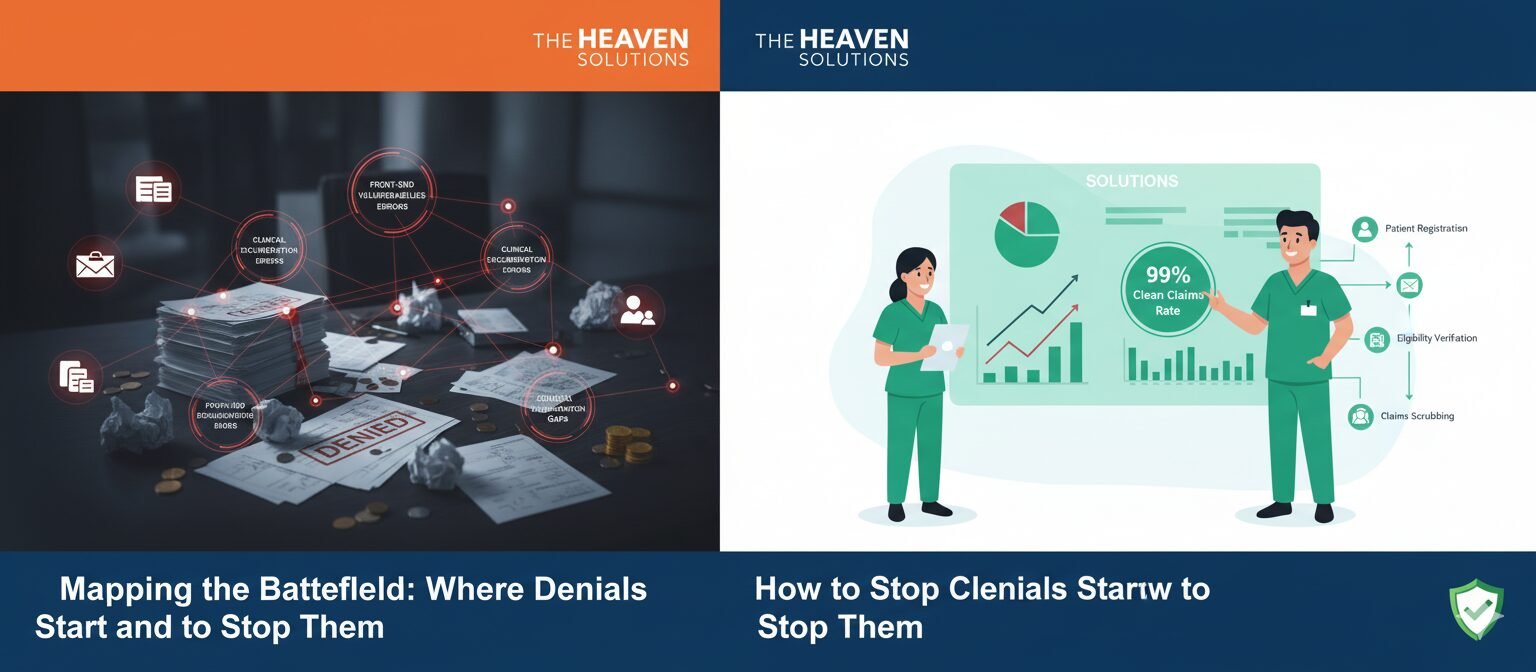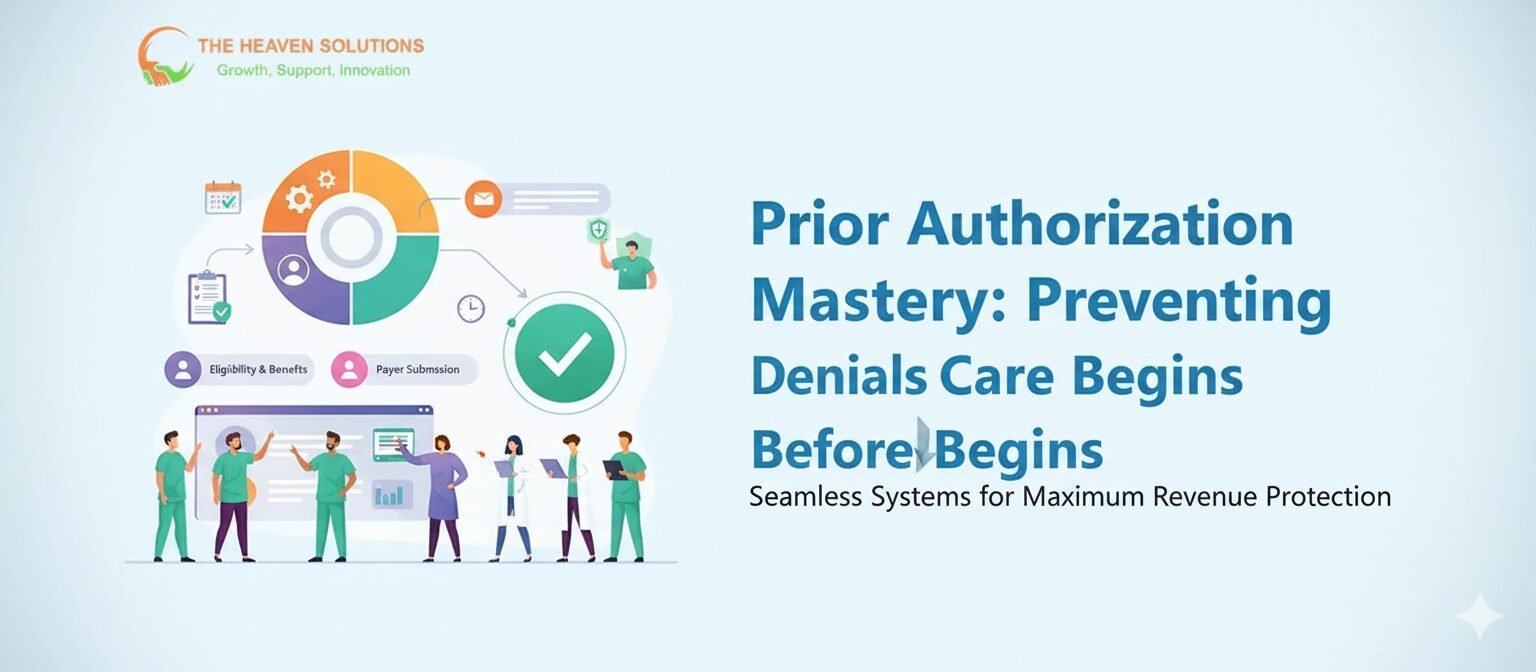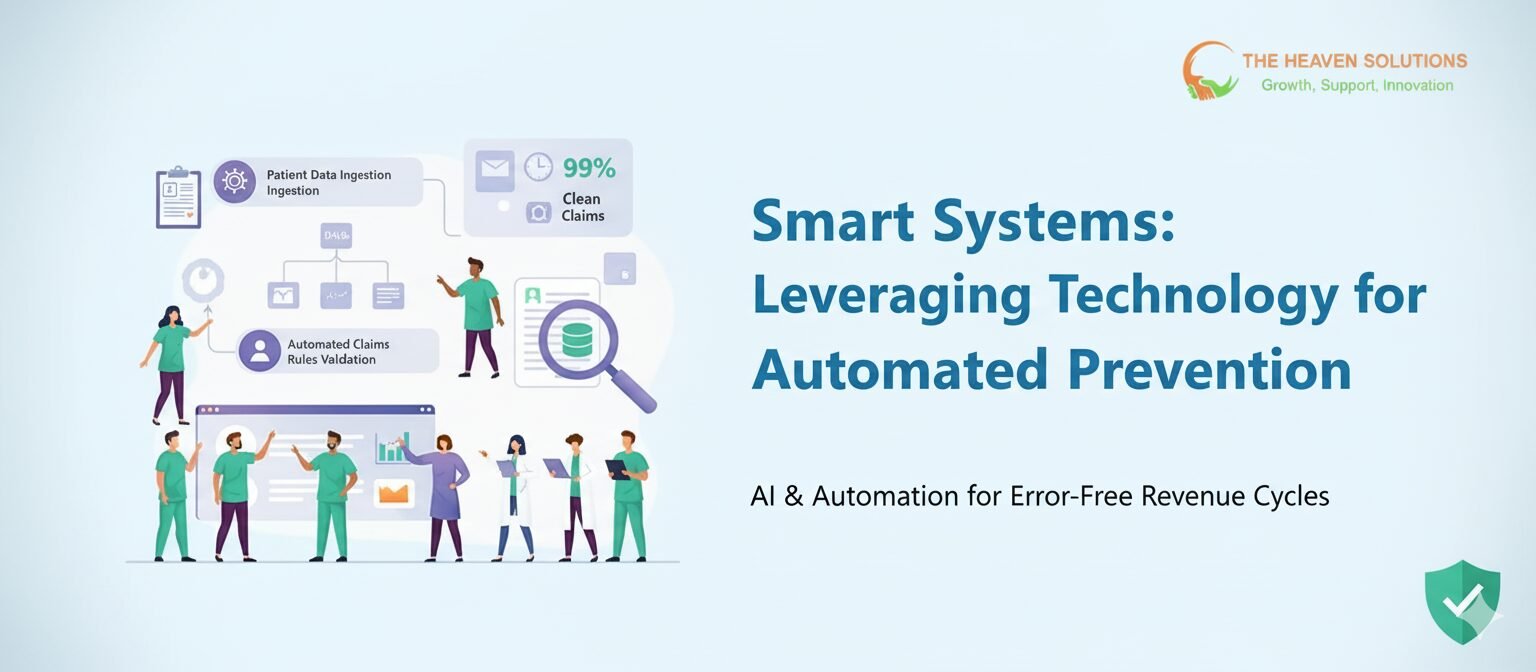RCM
Proactive Denial Prevention
Fearlessly
Win the Revenue Game Before It Starts
Featured Post
The Top Denial Reasons by Insurance Payers and How to Boldly Outsmart Them
What We offer:

Every denied claim costs your practice an average of $118 to resolve, but preventing that same denial costs only $25. The math is simple, yet 90% of healthcare practices still play defense instead of offense when it comes to denial management. They wait for problems to happen, then scramble to fix them, burning through staff time and administrative resources while watching revenue slip away.
But what if you could flip the script entirely? What if instead of fighting denials after they occur, you could stop them from happening in the first place? Proactive denial prevention transforms healthcare revenue cycle management from a costly defensive strategy into a profitable offensive approach that maximizes revenue while minimizing administrative burden.
This comprehensive guide reveals how healthcare practices can shift from reactive denial management to prevention strategies that protect revenue before problems occur. You’ll discover the systems, processes, and mindset changes that turn denial prevention into a competitive advantage that pays dividends every single day.
Why Reactive Denial Management Is Bleeding Your Practice Dry
Most healthcare practices are stuck in an expensive cycle of denial and recovery that drains resources without addressing root causes. They’ve accepted denial rates of 10-15% as normal, not realizing that proactive practices routinely achieve rates below 5%.
A poorly run cycle means a lot of lost cash, late payments, and a tremendous administrative strain that can put an entire operation at risk from the standpoint of both stability and growth.
The Hidden Economics of Prevention vs. Processing
The financial impact of reactive denial management extends far beyond the obvious costs. When you process a denial reactively, you’re not just paying for the staff time to research and appeal, but you’re also absorbing opportunity costs, delayed cash flow, and the revenue from denials that never get successfully resolved.
Consider a mid-sized practice processing 2,000 claims monthly with a 12% denial rate. That’s 240 denials per month, each requiring an average of 45-60 minutes to process. With a blended staff rate of $25 per hour, you’re spending $4,500-6,000 monthly just on denial processingbut$54,000-72,000 annually.
But prevention changes the equation dramatically. The same practice investing in proactive systems might spend $15,000 annually on prevention technology and training while reducing their denial rate to 4%. They’ve not only cut processing costs by two-thirds but also recovered an additional $96,000 in revenue that would have been lost to denials.
What is RCM in healthcare? Revenue cycle management encompasses all the processes that generate revenue for your practice, from patient registration to final payment collection. When denial prevention is built into your RCM strategy, every dollar spent on prevention typically returns $4-6 in saved processing costs and recovered revenue.
The Time Value Problem
Staff time spent on denial management represents your practice’s most expensive resource being used for its least productive purpose. Experienced clinical and administrative staff who could be focusing on patient care, practice growth, or prevention activities instead spend hours researching denied claims and preparing appeals.
Healthcare RCM research shows that practices with reactive denial management approaches require 40-60% more staff than those with effective prevention systems. This staffing difference becomes even more pronounced as practices grow, creating unsustainable resource requirements that limit expansion opportunities.
The opportunity cost extends beyond just staffing. When your revenue cycle is constantly disrupted by denial processing, cash flow becomes unpredictable, planning becomes difficult, and growth initiatives get delayed while you deal with preventable problems.

Mapping the Battlefield: Where Denials Start and How to Stop Them
Understanding where denials originate is crucial for building effective prevention strategies. Most denials stem from predictable problems that occur at specific points in the revenue cycle, making them highly preventable with the right systems and training in place.
Front-End Vulnerabilities
Registration and eligibility verification represent the largest source of preventable denials. Studies show that 40-50% of all denials originate from problems that could have been caught during patient registration. These include outdated insurance information, eligibility lapses, authorization requirements, and demographic errors.
The challenge is that many practices treat registration as a simple data entry task rather than a critical revenue protection activity. Staff members focused on getting patients checked in quickly may skip verification steps that prevent expensive problems later.
Modern revenue cycle management means real-time prevention at every touchpoint. When registration staff have access to automated eligibility verification, insurance card scanning, and benefit verification tools, they can catch problems immediately rather than discovering them weeks later when claims get denied.
Clinical Documentation Gaps
Medical necessity denials often stem from documentation that doesn’t clearly support the services provided. Providers may deliver appropriate care but fail to document their clinical reasoning in ways that satisfy payer requirements.
Different payers have different documentation preferences and requirements. Medicare focuses heavily on medical necessity and detailed clinical rationale, while commercial payers may emphasize authorization compliance and network requirements. Understanding these differences helps providers document services appropriately for each payer.
The benefits of revenue cycle management include systematic approaches to clinical documentation that support both quality care and clean claims processing. When providers understand how their documentation affects claim approval, they can adjust their approach without changing their clinical practice.
Coding and Billing Prevention Points
Coding errors represent another major category of preventable denials. These include incorrect procedure codes, diagnosis-procedure mismatches, modifier errors, and bundling violations. Many coding errors occur because staff don’t have access to real-time validation tools that catch problems before claims are submitted.
The revenue cycle in healthcare should include automated validation systems that check claims against payer-specific rules before submission. These systems can identify potential problems and suggest corrections while claims can still be fixed easily.
Registration and Eligibility: Your First Line of Revenue Protection
Front-end prevention starts with treating patient registration as a revenue protection activity rather than just an administrative task. Every piece of information collected during registration affects claim processing success, making accuracy and completeness critical.
Real-Time Verification Protocols
Modern eligibility verification goes far beyond checking whether a patient has insurance coverage. Comprehensive verification includes benefit details, remaining deductibles, authorization requirements, referral needs, and coverage limitations.
Real-time verification systems check eligibility at the moment services are scheduled and again when patients arrive for appointments. This dual verification catches problems that have developed between scheduling and service delivery, such as coverage lapses or policy changes.
Advanced verification systems also check historical patterns to identify potential red flags. If a patient’s coverage has been inconsistent or if they’ve had recent authorization problems, the system alerts staff to investigate further before services are provided.
Technology Integration for Prevention Success
Successful front-end prevention requires seamless integration between registration systems, practice management software, and payer databases. Manual processes are too slow and error-prone to provide effective prevention at the point of service.
Insurance card scanning technology eliminates transcription errors while capturing complete policy information, including group numbers, effective dates, and plan details that affect coverage decisions. Some systems can even identify when patients are using outdated cards or when their coverage has changed since their last visit.
Automated benefit verification pulls detailed coverage information directly from payer systems, providing staff with real-time data about deductibles, co-pays, authorization requirements, and service limitations. This information guides both clinical decision-making and financial counseling conversations.

Prior Authorization Mastery: Preventing Denials Before Care Begins
Prior authorization represents one of the most complex aspects of denial prevention, with requirements that vary by payer, procedure, and patient circumstances. Effective authorization management requires systematic tracking, automated alerts, and specialized staff training to ensure seamless operations.
Automated Authorization Tracking
Authorization requirements change constantly, and keeping track manually is nearly impossible. Automated tracking systems monitor authorization status throughout the treatment process, alerting staff when authorizations are approaching expiration or when renewals are needed.
These systems integrate with scheduling software to check authorization requirements when appointments are booked, ensuring that necessary approvals are obtained before services are provided. They also track authorization numbers and approval details to support claim submission.
Advanced tracking systems maintain databases of payer-specific authorization requirements, automatically flagging procedures that need approval and providing staff with the information needed to request authorizations efficiently.
Clinical Decision Support Integration
Authorization prevention works best when it’s integrated with clinical workflows rather than treated as a separate administrative task. Clinical decision support systems can alert providers when they’re ordering services that require authorization, enabling real-time authorization requests.
Integration with EHR systems provides authorization staff with immediate access to clinical information needed for approval requests, reducing preparation time and improving approval rates. The system can automatically populate authorization requests with relevant clinical data, streamlining the approval process.
What does RCM mean in healthcare? It includes ensuring that clinical and administrative systems work together seamlessly to support both quality care and financial success. Authorization integration represents a key component of this integration.
Documentation That Defends: Creating Bulletproof Clinical Records
Clinical documentation serves dual purposes: supporting quality patient care and justifying medical necessity for insurance coverage. Effective documentation prevention strategies help providers create records that satisfy both objectives without requiring extra work.
Medical Necessity Templates and Standards
Documentation templates help providers capture all the information that payers typically require for coverage decisions. These templates should be customized for different procedure types and payer requirements, ensuring that clinical notes include relevant details for claim approval.
Effective templates prompt providers to document the clinical reasoning behind treatment decisions, including why alternative approaches weren’t appropriate and how the chosen treatment addresses the patient’s specific condition. This narrative approach helps payers understand the medical necessity of services.
The templates should also guide providers in documenting relevant risk factors, comorbidities, and complications that support higher levels of service or justify unusual treatment approaches. Comprehensive documentation provides a complete picture that supports claim approval.
Provider Education and Training
Many providers don’t realize how their documentation affects claim processing and revenue cycle performance. Education programs help providers understand the connection between clinical documentation and financial success without compromising clinical care.
Training should focus on payer-specific requirements and preferences, helping providers understand what different insurance companies look for in documentation. Medicare documentation requirements differ significantly from commercial payer preferences, and providers benefit from understanding these variations.
Regular feedback sessions help providers see how their documentation affects claim approval rates and identify opportunities for improvement. Positive reinforcement for good documentation practices encourages continued attention to this critical revenue protection activity.

Smart Systems: Leveraging Technology for Automated Prevention
Technology amplifies human expertise rather than replacing it, providing automated validation, real-time alerts, and predictive insights that prevent problems before they occur.
Claims Scrubbing and Validation
Pre-submission validation systems check claims against hundreds of payer-specific rules before claims leave the practice. These systems identify potential problems and suggest corrections while claims can still be fixed easily and inexpensively.
Advanced validation systems use artificial intelligence to identify subtle patterns that might lead to denials. They can recognize when procedure-diagnosis combinations are likely to trigger medical necessity reviews or when authorization requirements might apply to specific services.
The systems learn from historical denial patterns to improve their predictive accuracy over time. Claims that triggered denials in the past are flagged for additional review, helping practices avoid repeating previous mistakes.
Predictive Analytics for Prevention
Machine learning algorithms analyze historical claim and denial data to identify patterns that predict future problems. These systems can flag high-risk claims before submission and recommend specific interventions to prevent denials.
Predictive systems consider multiple factors, including payer behavior patterns, seasonal trends, regulatory changes, and practice-specific variables. They provide risk scores that help staff prioritize prevention efforts where they’re most needed.
The analytics also identify systemic issues that affect multiple claims, enabling practices to address root causes rather than just treating symptoms. When a particular diagnosis-procedure combination consistently generates denials from a specific payer, the system alerts staff to investigate policy changes or coverage limitations.
Beyond Tools: Creating a Culture of Prevention Excellence
Technology and processes are important, but sustainable prevention requires building a practice culture where everyone understands their role in protecting revenue and takes responsibility for prevention activities.
Leadership Commitment and Communication
Prevention culture starts with leadership commitment to proactive rather than reactive approaches. When practice leaders prioritize prevention and provide necessary resources, staff members understand that prevention is valued and expected.
Regular communication about prevention performance helps maintain focus on proactive strategies. Monthly reports showing denial rates, prevention activities, and financial impact keep prevention visible and demonstrate its value to the practice.
Recognition programs acknowledge staff members who contribute to prevention success, creating positive reinforcement for continued attention to prevention activities. Recognition doesn’t have to be expensive, but often a simple acknowledgment of good work is sufficient motivation.
Cross-Departmental Collaboration
Effective prevention requires coordination between clinical, administrative, and billing staff. Each department contributes different pieces of the prevention puzzle, and coordination ensures that all activities support common prevention goals.
Regular interdisciplinary meetings provide forums for discussing prevention challenges, sharing successful strategies, and coordinating improvement efforts. These meetings help identify systemic issues that affect multiple departments and develop comprehensive solutions.
Performance metrics should reflect collaborative success rather than individual department performance. When prevention metrics are shared across departments, staff members understand how their work affects overall practice success.
Metrics That Matter: Tracking and Improving Prevention Performance
Effective prevention requires systematic measurement and continuous improvement based on performance data and staff feedback.
Key Performance Indicators for Prevention
Denial rate represents the most obvious prevention metric, but leading indicators provide an earlier warning of potential problems. Registration accuracy rates, eligibility verification completion, and authorization compliance all predict future denial performance.
Financial metrics should include both direct savings from prevented denials and indirect benefits from improved cash flow and reduced administrative burden. Many practices find that prevention benefits extend beyond simple cost avoidance to include improved staff satisfaction and enhanced patient experience.
Benchmarking against industry standards helps identify improvement opportunities and validate prevention investments. Revenue cycle management services can provide comparative data that shows how your prevention performance compares to similar practices.
Continuous Improvement Methodologies
Regular performance reviews identify trends and patterns that guide strategic decisions about prevention investments and training priorities. Monthly analysis helps catch emerging problems before they significantly impact performance.
Root cause analysis of breakthrough denials helps identify prevention system gaps and guides process improvements. When denials occur despite prevention efforts, understanding why helps strengthen future prevention activities.
Staff feedback integration ensures that prevention systems evolve based on practical experience and changing circumstances. The people who use prevention tools daily often have valuable insights about workflow improvements and system enhancements.
Building Your Prevention Advantage
Proactive denial prevention represents the future of successful revenue cycle management, offering healthcare practices a clear path to reduce administrative costs while maximizing revenue collection. The practices that embrace prevention strategies today will maintain competitive advantages tomorrow.
Start by conducting a comprehensive assessment of your current denial patterns to identify the prevention opportunities with the greatest financial impact. Focus initial efforts on high-volume, preventable denial types where success will be most visible and valuable.
Consider partnering with experienced healthcare revenue cycle management companies that understand both prevention strategies and implementation challenges. Professional guidance can accelerate your success while helping you avoid common pitfalls that delay results.
The investment in comprehensive prevention systems pays dividends through reduced denial rates, improved cash flow, enhanced staff productivity, and sustainable competitive advantages. Most importantly, prevention transforms denial management from a cost center into a profit center that supports practice growth and financial stability.
Your practice has invested significant resources in providing quality patient care. Proactive denial prevention ensures that you collect the revenue you’ve earned while creating systems that support continued growth and success. With systematic prevention strategies, appropriate technology investments, and commitment to continuous improvement, you can win the revenue game before it even starts.
